by Bruce Wells | Dec 2, 2025 | Petroleum Pioneers
The lucky life of John Steele and America’s earliest oil wealth.
John Washington Steele’s good fortune began on December 10, 1844, when Culbertson and Sarah McClintock adopted him as an infant. The McClintocks also adopted his sister Permelia, bringing both home to the farm along Oil Creek in Venango County, Pennsylvania.
Fifteen years later, the U.S. petroleum industry began with a 69.5-foot-deep oil discovery at nearby Titusville, the first oil well drilled commercially for distilling into kerosene (also called coal oil).
Pennsylvania petroleum reserves revealed at Oil Creek made the widow McClintock a fortune in royalties. When she died in a kitchen fire in 1864, Mrs. McClintock left her oil wealth to her only surviving child, Johnny, who inherited $24,500 at age 20.
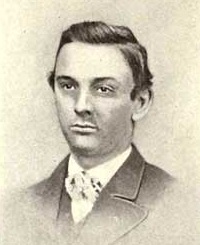
John Washington Steele of Venango County, Pennsylvania, inherited oil riches.
Johnny also inherited his mother’s 200-acre farm along Oil Creek between the now Rynd Farm and the small community of Rouseville, south of 15-miles Titusville. The farm already included 20 producing oil wells yielding $2,800 in royalties every day.
Rouseville was where future muckraking journalist Ida Minerva Tarbell (1857-1944) lived in 1861, when a gushing well erupted into flames — resulting in an early petroleum industry tragedy (see Rouseville 1861 Oil Well Fire).
Legendary Extravagance
“Coal Oil Johnny” Steele would earn his famous name in 1865 — after less than one year of extravagance, according to the New York Times.

“In his day, Steele was the greatest spender the world had ever known,” the newspaper proclaimed. “He threw away $3,000,000 in less than a year.”
Philadelphia journalists coined the name “Coal Oil Johnny” for him, reportedly because of his attachment to a custom carriage that had black oil derricks spouting dollar symbols painted on its red doors. He later confessed in his autobiography:
I spent my money foolishly, recklessly, wickedly, gave it away without excuse; threw dollars to street urchins to see them scramble; tipped waiters with five and ten dollar bills; was intoxicated most of the time, and kept the crowd surrounding me usually in the same condition.

“Before J.R. Ewing, or the Beverly Hillbillies, or even John D. Rockefeller, there was Coal Oil Johnny,” noted a 2010 article in The Atlantic.
Such wealth could not last forever, but the rise and fall of Coal Oil Johnny, who died in modest circumstances in 1920 at age 76, has lingered in America’s petroleum history.
In 2010, The Atlantic magazine published “The Legend of Coal Oil Johnny, America’s Great Forgotten Parable,” an article sympathetic to his riches-to-rags story. It describes the country’s fascination with the earliest economic booms brought by “black gold” discoveries in Pennsylvania.

“Before J.R. Ewing, or the Beverly Hillbillies, or even John D. Rockefeller, there was Coal Oil Johnny,” noted the October 18 feature story. “He was the first great cautionary tale of the oil age — and his name would resound in popular culture for more than half a century after he made and lost his fortune in the 1860s.”
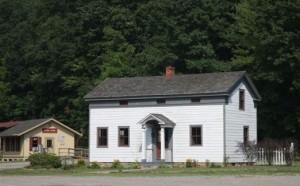
Refurbished boyhood home of “Coal Oil Johnny” at Oil Creek State Park (and train station) north of Rouseville, Pennsylvania. Photo by Bruce Wells.
For generations after the peak of his career, Johnny was still so famous that any major oil strike — especially the January 1901 gusher at Spindletop Hill in Beaumont, Texas — “brought his tales back to people’s lips,” noted the magazine article, citing Brian Black, a historian at Pennsylvania State University.
“It was wealth from nowhere,” Black explained. “Somebody like that was coming in without any opportunity or wealth and suddenly has a transforming moment. That’s the magic and it transfers right through to the Beverly Hillbillies and the rest of the mythology.”
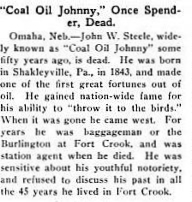
John W. Steele, who “made one of the first great fortunes out of oil,” died in 1920 in Nebraska.
“Coal Oil Johnny” was a legend, and like all legends, “he became a stand-in for a constellation of people, things, ideas, feelings and morals – in this case, about oil wealth and how it works,” he added.
“He made and lost this huge fortune – and yet he didn’t go crazy or do anything terrible. Instead, he ended up living a regular, content life, mostly as a railroad agent in Nebraska,” the 2010 Atlantic article concluded. “Surely there’s a lesson in that for the millions who’ve lost everything in the housing boom and bust.”
John Washington Steele’s Venango County home, relocated and restored by Pennsylvania’s Oil Region Alliance of Business, Industry & Tourism, stands today in Oil Creek State Park, just off Route 8, north of Rouseville.

On Route 8 south of Rouseville is the still-producing McClintock No. 1 oil well. “This is the oldest well in the world that is still producing oil at its original depth,” proclaims the Alliance. “Souvenir bottles of crude oil from McClintock Well Number One are available at the Drake Well Museum, outside Titusville.”
_______________________
Recommended Reading: The Legend of Coal Oil Johnny (2007); Cherry Run Valley: Plumer, Pithole, and Oil City, Pennsylvania, Images of America (2000); Western Pennsylvania’s Oil Heritage (2008). Your Amazon purchase benefits the American Oil & Gas Historical Society. As an Amazon Associate, AOGHS earns a commission from qualifying purchases.
_______________________
The American Oil & Gas Historical Society (AOGHS) preserves U.S. petroleum history. Please become an AOGHS annual supporter and help maintain this energy education website and expand historical research. For more information, contact bawells@aoghs.org. Copyright © 2025 Bruce A. Wells. All rights reserved.
Citation Information – Article Title: Legend of “Coal Oil Johnny.” Authors: B.A. Wells and K.L. Wells. Website Name: American Oil & Gas Historical Society. URL: https://aoghs.org/petroleum-pioneers/legend-of-coal-oil-johnny. Last Updated: December 4, 2025. Original Published Date: April 29, 2013.
by Bruce Wells | Oct 15, 2025 | Petroleum History Almanac
A simple forum for sharing ideas and research — and preserving history.
The American Oil & Gas Historical Society (AOGHS) established this oil history forum page to help share research. For oilfield-related family heirlooms, the society also maintains an Oil & Gas Families page to locate suitable museum collections for preserving these unique histories. Information about old petroleum company stock certificates can be found at the popular forum linked to Is my Old Oil Stock worth Anything?
Our forum below offers a simple way to share personal or academic research, subject ideas, comments, and other details about petroleum history. You can email the society at bawells@aoghs.org if you would like your research question posted. Please use the comment section at the bottom of this page to answer or make suggestions!
Request: November 21, 2025
1914 Socal Tanker served in WWII
Searching for the SOCAL publication featuring the 1914 launch of the company tanker J.A. Moffett, which served in WWII.
Hello. I’m trying to find out if American Oil & Gas Historical Society website visitors have any information about the December 1914 Standard Oil Company of California “Standard Oil Bulletin.”
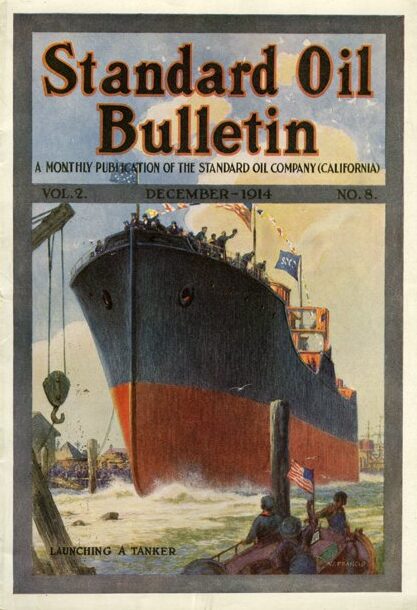
Created with the breakup of Standard Oil in 1911, Standard Oil of California (SOCAL) became Chevron in 1984.
The cover story for that “Standard Oil Bulletin” featured the tanker J.A. Moffett. My dad was on that tanker in World War II in the Pacific, and I’m trying to find a copy or the J.A. Moffett article. Thank you.
— Pat
Editor’s Note: Another tanker, the J. A. Moffett Jr., built in 1921, was torpedoed in 1942 in the Florida Keys. Please post your reply in comments section below or email bawells@aoghs.org
Research Request: November 16, 2025
Hand-cranked Bowser Pump
Scottish researcher seeks details about a salvaged pump manufactured by S.F. Bowser & Company.
I have an old hand-crank petrol pump that I salvaged from a demolition site. The body can be closed and locked by swinging a curved door round. It’s possible to just make out the word Bowser on a part. It has a light bulb holder up top where a glass globe could be fitted and two other bulb holders to shine downwards. It can be set to serve a pint, a quart, a half gallon or a gallon.
I’d love to know more about it but can’t find an image anywhere showing the same appliance.
Douglas Robertson
Please post oil history forum replies in the comments section below or email douglasinscotland@gmail.com
Research Update: November 12, 2025
Antique Calculator: The Slide Rule
Searching for the history of a Tulsa refining supply company pocket calculator.
David Rance of Sassenheim, Netherlands, has collected a lot of slide rules. Some of the calculators in his collection came from the petroleum industry, including a circa 1950 one made in West Germany for an Oklahoma-based refinery supply company. He seeks any information about it.
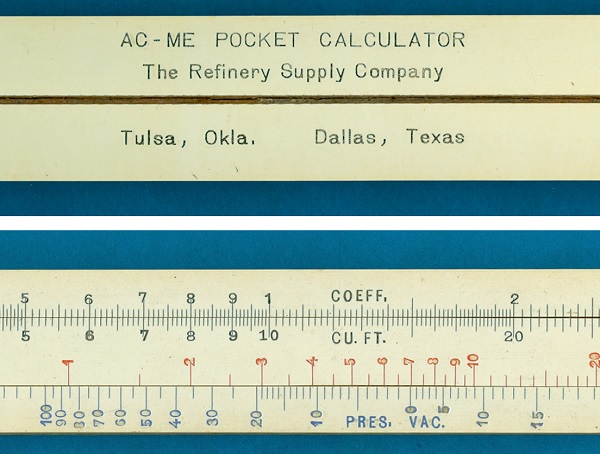
An “AC-ME Pocket Calculator,” of the Refinery Supply Company, Tulsa, Oklahoma, preserved by David Rance of the Netherlands.
“I look forward to hearing anything your knowledgeable AOGHS community can tell me about my rather mysterious AC-ME Pocket Calculator,” he optimistically noted in 2016 — see the updated Refinery Supply Company Slide Rule.
Please post oil history forum replies in the comments section below or email bawells@aoghs.org.
Research Update: October 28, 2025
Ohio Oil Rush
Exploring Ohio petroleum history from 1885 to about 1930.
Does anyone have recommendations for doing research on the great oil rush of Ohio that occurred from 1885 to ~1930, and peaked in 1897? Are there any good reference books that anyone can recommend? I am trying to research this oil boom and its effect on the construction of an interurban rail connection from Toledo to Lima.
Dave Weber
Also see Oil History Books. Please post your reply in comments section below or email bawells@aoghs.org.
Research Update: August 18, 2025
California Adventures in Oil
City Planning Associate for Los Angeles shares research resources.I’m a subscriber to your “Oil & Gas History News.” It’s great content to review and learn about the oil industry’s history. I work in Los Angeles on land use/zoning regulations for oil wells in the city, and I’m currently reading a couple of older publications from the public library. Among the images is offshore drilling at the Summerland field that you recently highlighted in your newsletter.
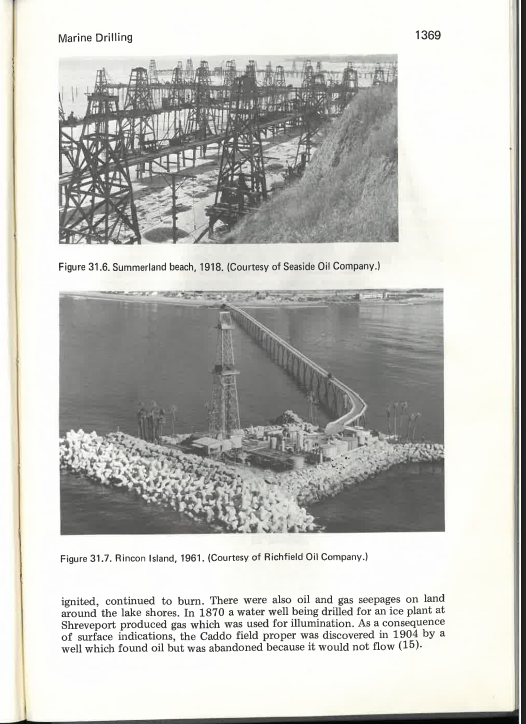
Coastal California oilfields are featured among the 1,500 pages of History of Oil Well Drilling by John E. Brantly.
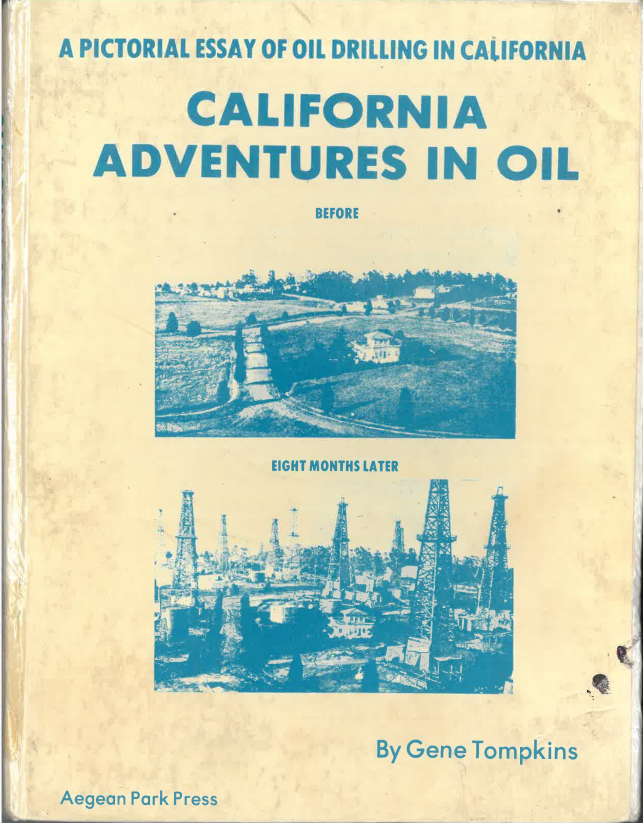
Before retiring as an independent producer in 1963, Eugene Thompkins founded several oilfield service companies, including one that operated at Signal Hill for two decades.
I just thought to share a few PDFs of Summerland photos from History of Oil Well Drilling (1971) by John E. Brantly, pages 1366-1369, and more images from California Adventures in Oil, A Pictorial Essay of Oil Drilling in California (1981) by Gene Tomkins, which might be of interest to your readers. Keep up the great content; much appreciated. — Edber Macedo, City Planning Associate, Office of Zoning Administration, Los Angeles City Planning
Please post your reply in comments section below or email bawells@aoghs.org
Research Request: July 9, 2025
Desdemona Oil & Refining Company
Editor for International Bond and Share Society seeks source material for circa 1920 Texas company established during the North Texas drilling booms at Electra (1911), Ranger (1917), and Burkburnett (1918).
I’ve been subscribing for a few months and want to thank you for revealing so many obscure technologies and historical artifacts. I collect vintage stocks and bonds (all businesses, not just oil) and have always found it difficult to research these often obscure gas and oil companies. So far, I’ve not been successful in linking a certificate to any of the outfits you’ve mentioned, but it’s just a matter of time.
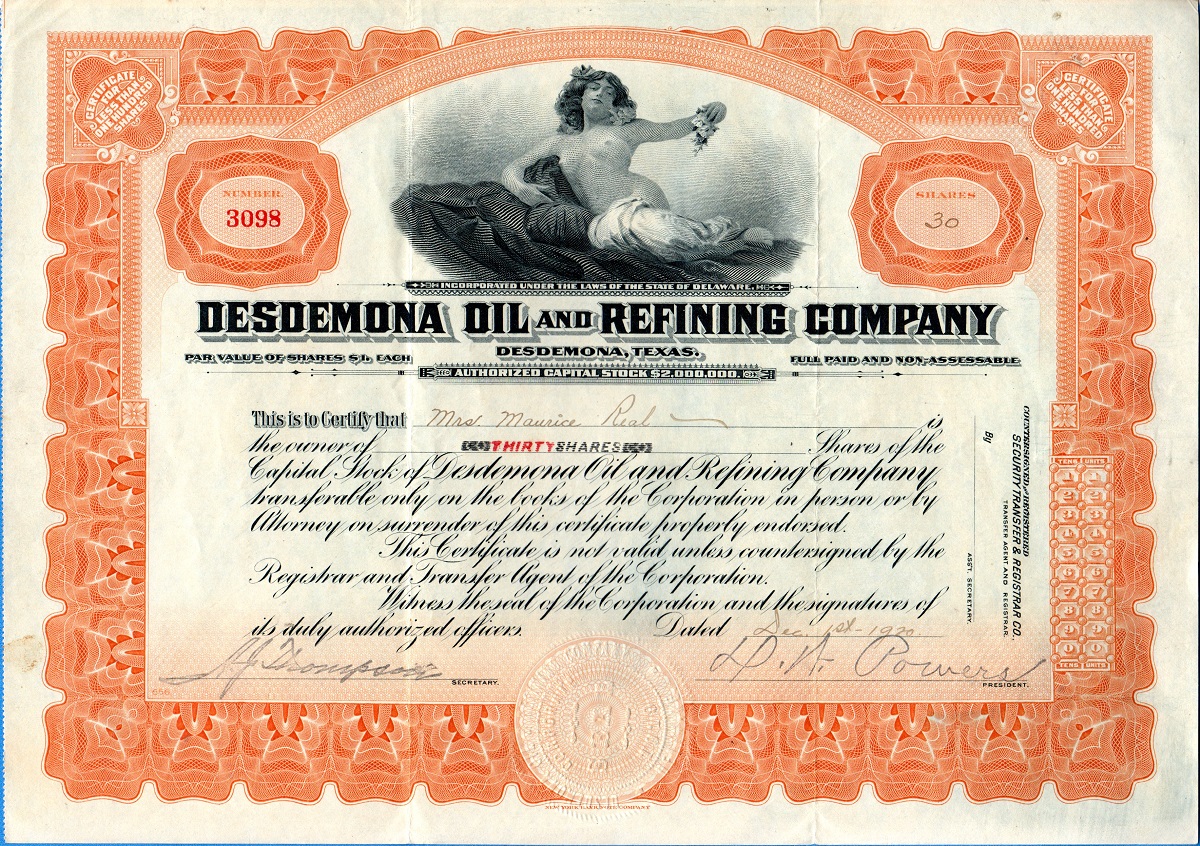
I recently wrote an article on the Indian Territory Illuminating Oil Co. that was published in the magazine I edit for the International Bond and Share Society, Scripophily. A stock I’ve been trying to research — without much luck — is the Desdemona Oil & Refining Company. If your members have any source material on this outfit, I’d be grateful.
Keep up the good work. — Max Hensley
Please post your reply in the comments section below or email maxdhensley@yahoo.com
Research Request: April 4, 2025
Standard Oil Public Relations Movie
Looking into 1947 film “A Farm In The Valley.”
Hello. My name is Carrie. My family is looking for a film that Standard Oil Company made in Virginia in 1947. It was titled “A Farm In The Valley.” I have several news articles but am looking for the film and/or any information that may be out there as part of the film was filmed on our farm (owned by the Rosen family at the time). I am hoping that maybe your group may have information or contact information for someone who may have information!
— Carrie
Please post your reply in comments section below or email bawells@aoghs.org
Research Request: November 14, 2024
Looking for The Gargoyle of Mobiloil
Pennsylvania researcher seeks a 1920s company magazine featuring her grandfather, “The Mobiloil King.”
I am in search of a copy of The Gargoyle magazine published by the Vacuum Oil Company from 1923. My great-grandfather, William I. Schreck was proprietor of the Keystone Service Station in Sayre, Pennsylvania, in the 1920’s and was locally dubbed “The Mobiloil King.”
I found an article on Newspapers.com — September 15, 1923 issue of the Sayre Evening Times, which states he was featured in The Gargoyle magazine, with two photos of his service station and an article written by him. I’m guessing it’s maybe the August 1923 or September 1923 issue. Any help locating this would be appreciated!
— Raquel
Please post your reply in comments section below or email bawells@aoghs.org
Research Request: November 8, 2024
Early Oilfield Production Technology
Artist seeks jerker/shackles for 2026 exhibition.
I am interested in the jerker/shackle lines used in early oil production for an exhibition I am planning for 2026. Does this oilfield equipment (entire assemblies or parts) ever come up for sale or auction? Perhaps there are private collectors or oil museums that might be interested in renting or lending some temporarily?
Best,
Aislinn
Please post your reply in comments section below or email bawells@aoghs.org (also see Eccentric Wheels and Jerk Lines).
Research Request: October 7, 2024
Researching Tidewater Oil Company
Researcher from Lancaster, Pennsylvania, seeks more about 1930s publication.
Hello: My grandfather authored an article in “The Tidewater World” in September 1932 (Vol. 2, No. 2). I have one complete issue. He worked in the Research and Development area of Tidewater Oil in Bayonne, New Jersey, 1928-1933.

Founded in 1887 in New York City, Tidewater Oil Company became a major refiner that sold its Tydol brand petroleum products on the U.S. East Coast. Photo courtesy Mark O’Neill.
I am looking for archives who may have additional issues in the series or who has a research focus on Tidewater Oil. Thank you.
— Mark O’Neill
Please call Mark at (717) 803-9918 or post reply in the comments section below.
Research Request: April 20, 2024

Wayne Canada Gasoline Pump
Preserving a rare 1930s Wayne Canada pump.
I recently saved an uncommon Wayne 50A “showcase” gas pump from a metal recycling facility here in Canada. I didn’t have much time for details as it was literally standing in the scrap yard beside the metal chipping machine. I paid the asking price and loaded it into my truck.
Upon arriving home I noticed that the I.D tag was a Wayne Canada, which was a surprise because the odds of it being a Canadian Showcase pump are significantly smaller than American as Canada had far fewer of the 50 and 50A pumps for obvious reasons. The I.D tag got me curious however, as it is stamped 1001-CJXA.
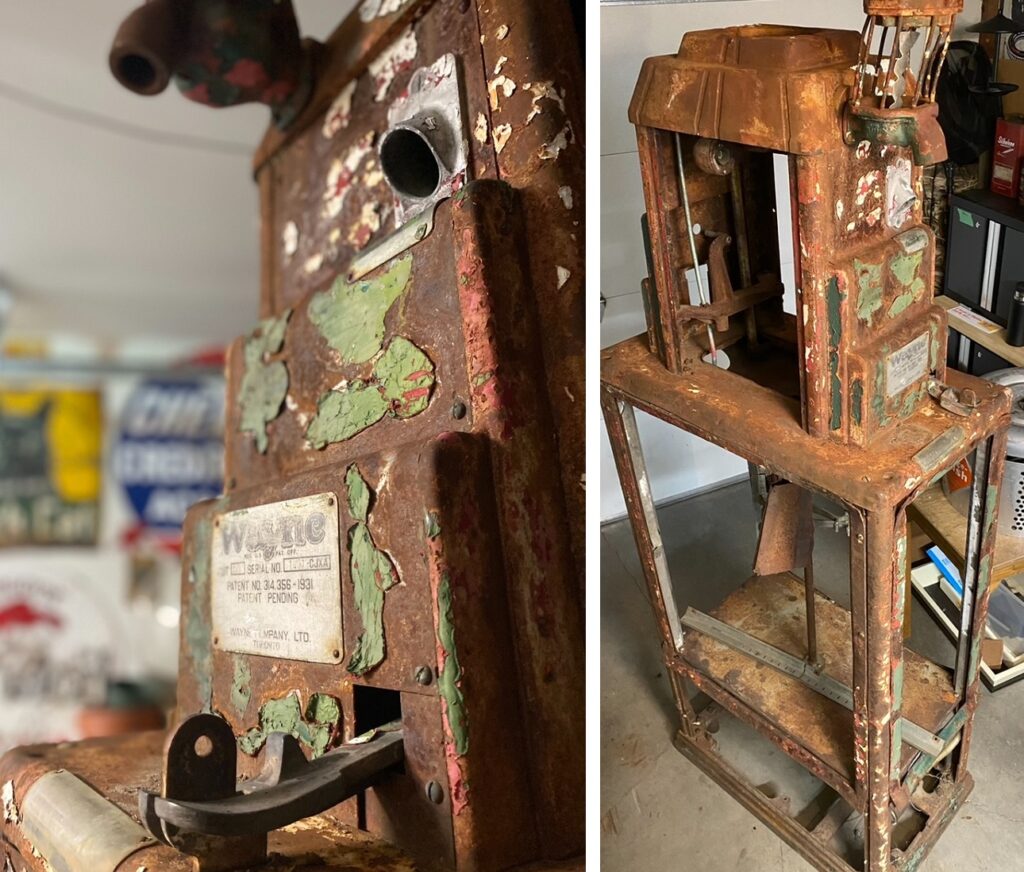
Canadian researcher seeks information about a rare 1930s Wayne Company pump 1001-CJXA.
Is there any way to determine which company ordered this exact gas pump? Is it true that the “1001” number would indicate that this is serial number 1 in Canada for this gas pump? I was told once that Wayne pumps in the 1930s began with the number 100 meaning 100.1 would be serial number 1. I’m not sure if that’s true.
Thanks very much for any help. I’m aware of the pumps rarity and historical significance, hence why I’m trying to find more information on it. Have a great day.
— Jonathan Rempel
Note: The Wayne Oil Tank and Pump Company of Ft. Wayne, Indiana, in 1892 manufactured a hand-cranked kerosene dispenser later converted for gasoline (see Wayne’s Self-Measuring Pump). Primarily Petroleum (oldgas.com) includes research posts with service station histories and gas pump collections; other resources include community oil and gas museums and the Canadian oil patch historians at the Petroleum History Society (PHS).
Please email jrrempel123@gmail.com or post reply in the comments section below.
Research Request: April 20, 2024
Name of Offshore Drilling Rig
Seeking the name of ODECO platform from 1970s.
I’m doing research on my late father, James R. Reese Sr., who worked in the Gulf of Mexico in the early 1970s and into the 1980s, and I’m trying to find the name of a rig he worked on for ODECO. We believe it may have been called the Ocean Endeavour, and we have a photo from my father’s 10th anniversary at the company with “Odeco 7” written on the back. My research points to the Endeavour, but I’m not confident of that. Has anyone heard of the platform and any other name it might have had?
Thank you for any help.
— James Reese Jr.
Note: ODECO (Ocean Drilling & Exploration Company) was founded in 1953. It was acquired by Diamond Offshore Drilling in 1992.
Please email tepapa@hotmail.com or post reply in the comments section below.
Research Request: March 29, 2024
Eastern Oklahoma History
Writer looking to connect petroleum exploration and railroad growth.
I’m writing a memoir that touches on Oklahoma, where I’m from originally, and I would like to learn more about what role did oil and gas exploration played in the expansion of the railroads into the Cherokee Nation in eastern Oklahoma in the late 1800s.
— Dave
Please post reply in comments section below or email bawells@aoghs.org.
Research Request: February 22, 2024
Threatt Filling Station on Route 66
Architectural history of potential National Historic Landmark.
Established in the early 1920s, the Threatt Filling Station in Luther, Oklahoma, is considered the first – and potentially only – African American owned and operated gas station on Route 66. I am under contract with the National Park Service to perform a study to determine whether the the station is eligible to become a National Historic Landmark.

Constructed circa 1915 in Luther, Oklahoma, by Allen Threatt Sr., the Threatt Filling Station sold Conoco products for at least a portion of its many decades of service life, according to the Threatt Filling Station Foundation. Photo courtesy threattfillingstation.org.
What I am looking for is an Oklahoma contact, who has knowledge of the history of gas-oil distribution in the Sooner State in the 1920s-40s period. It appears that at one point, the Threatts were associated with Conoco. I would like to better understand how those supply-branding operations worked and whether there is historical paperwork that would cover this station.
Any assistance will be appreciated. Thank you,
— John
Please email john@archhistoryservices.com or post reply in the comments section below.
Research Request: January 2, 2024
Oil Refinery and R.R. Trackside Building Photos
Model railroader seeks detailed images of facilities in Santa Fe Springs and Los Angeles.
Thank you for sharing most interesting and valuable information. I use your society to help me with prototype research for my model railroading.
I am looking for information on the Powerine Oil Refinery at Santa Fe Springs circa 1950s and the trackside Hydril Oil Field Equipment buildings on approach to Los Angeles Union Passenger Terminal, and photos and dimensions of buildings/building interiors for model railroading purposes.
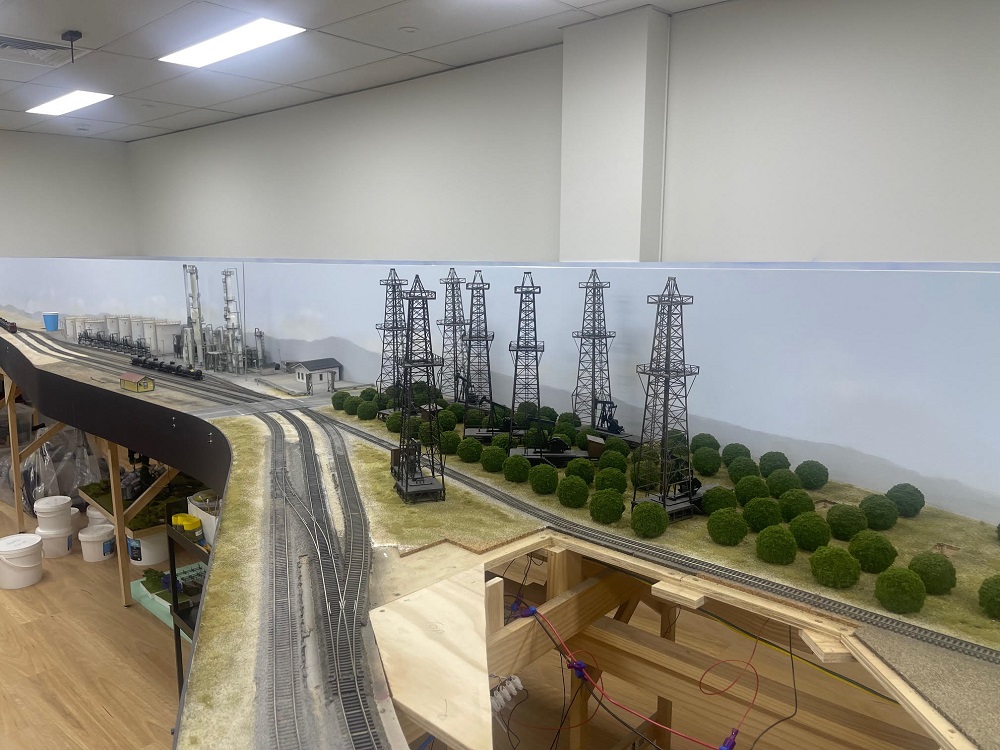
A model railroad scene of the southern California petroleum industry in the 1950s includes oil derricks, “each with an operating horsehead style oil pump underneath.”
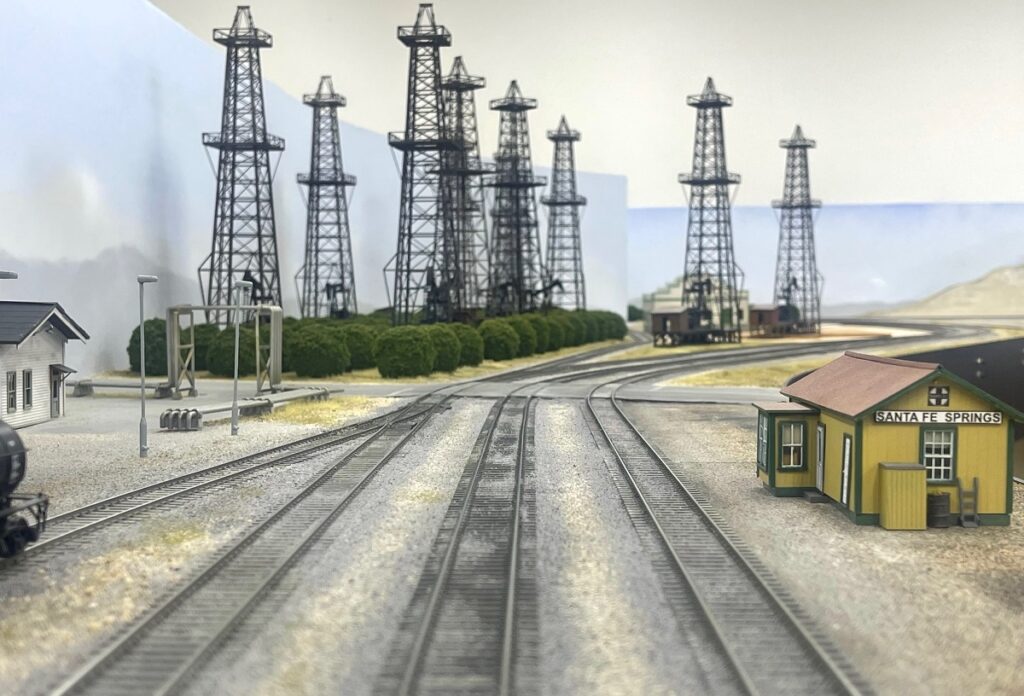
Justin Mitchell has recreated trackside oilfield derricks at Santa Fe Springs and researched oilfield engine audio files, “so I can add sound to the layout to match the operating pumps.”
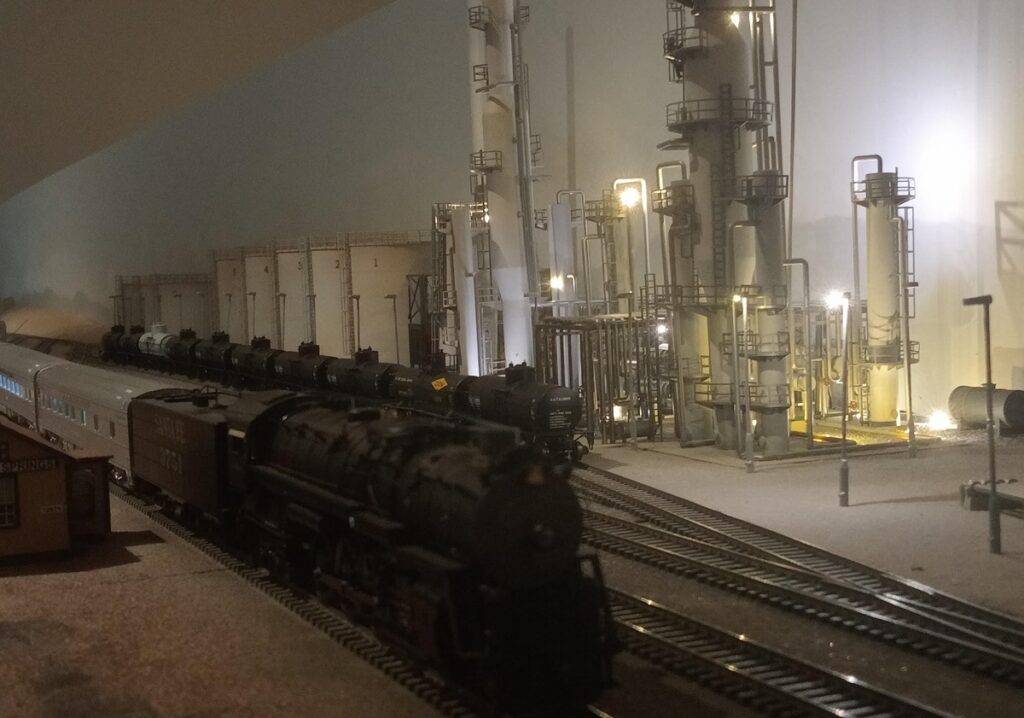
The Powerine Oil Refinery at Santa Fe Springs closed in 1995. Skilled model railroaders prize detail and historical accuracy.
Best regards from Sydney, Australia
— Justin Mitchell
Please post reply in comments section below or email bawells@aoghs.org.
Research Request: December 26, 2023
Cities Service in Wichita
Seeking service station photos.
I am looking for photographs of a Cities Service Station located at 610 N. Seneca Street in Wichita, Kansas, in the 1950s, maybe early 60s. I have my father’s business card from that station. I remember the service station even though I was only 4 years old. Any assistance is greatly appreciated.
— Pamela
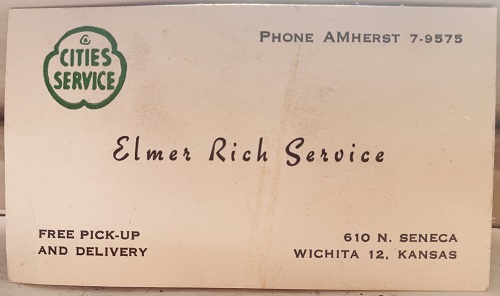
Please post reply in comments section below or email bawells@aoghs.org.
Research Request: September 25, 2023
Circa 1930 Driller from Netherlands
From a researcher investigating a great-great uncle’s role in the Texas oil patch.
A family history researcher in the Netherlands seeks help adding to her limited information about a great-great uncle who worked for J. Barry Fuel Oil Company in Texas oilfields from the 1920s to the early 1930s. The petroleum-related career of Ralph “Dutch” Weges included traveling on an early oil tanker later sunk during World War I.
Learn more and share research in Driller from Netherlands.

Research Request: July 13, 2023
How and Where Standard Oil produced Naphtha
From a writer working on a history of the lighting of New York City.
In the late 19th century, Standard Oil gained control of all of the gas lighting companies in New York. My understanding is that they did so in part because the gas companies at the time produced something called water gas, which relied on the use of naphtha, and Standard Oil produced almost all of the naphtha in the United States.
How and where Standard Oil produced its naphtha around 1890-1900 and how it would have transported it to the NYC gas companies? Would it have been produced in the Midwest and shipped east by pipeline? Railcar? Did they ship crude oil east and refine it into naphtha somewhere on the East Coast?
Also, any suggestions for where I could find info on how much naphtha Standard Oil produced around that time and, perhaps, how much of it was shipped to New York? I have looked in all the standard histories and tried every Google and newspaper searches. Can anyone offer suggestions? Thanks very much.
— Mark
Please post reply in comments section below or email bawells@aoghs.org.
Reply
August 26, 2023, from Reference Services, American Heritage Center
The American Heritage Center at the University of Wyoming does hold a set of records for the Standard Oil Company of New Jersey, 1874-1979. The online guide is posted here. This is one of our older guides not yet converted to the online format, and it includes many handwritten notes about the removal of items from this manuscript collection to other collections.
— American Heritage Center, University of Wyoming
Research Request: June 23, 2023
Houston Petrol Filler
From an Australian “petrol bowser” researcher
I recently came across this brass fitting which is clearly marked THE HOUSTON PETROL FILLER Pat 1307. The patent number is extremely early. I am assuming it is part of an early petrol pump or as we call them here in Australia, a petrol bowser. Is there any chance anyone can identify what this was originally part of. Many thanks for your help. Regards.
— Justin
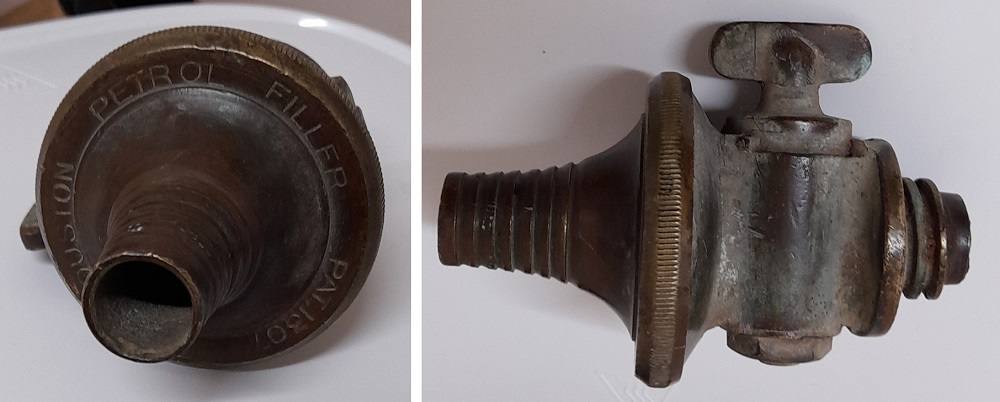
Please post reply in comments section below or email bawells@aoghs.org.
Reply
October 18, 2023 (also from Australia)
Hello Justin,
I have one of these that has turned up in my late father’s stuff. Identical to yours except for the screwed end which has a strangely shaped protrusion. I’ll send you a pic if you are interested. Did you ever find out anything about it? I’m looking for somewhere to donate it — where it will be appreciated.
Regards, David
Please post reply in comments section below or email bawells@aoghs.org.
Research Request: April 12, 2023
Information about Wooden Barrel
From researcher who has a barrel with a red star and
I have got this old oil barrel. I’m trying to find out more information about it. I’m guessing around the 1920’s but I really have no clue. I was hoping someone there could shed some light on it. I’m not interested in selling it just some information. Much appreciated!
— Robert
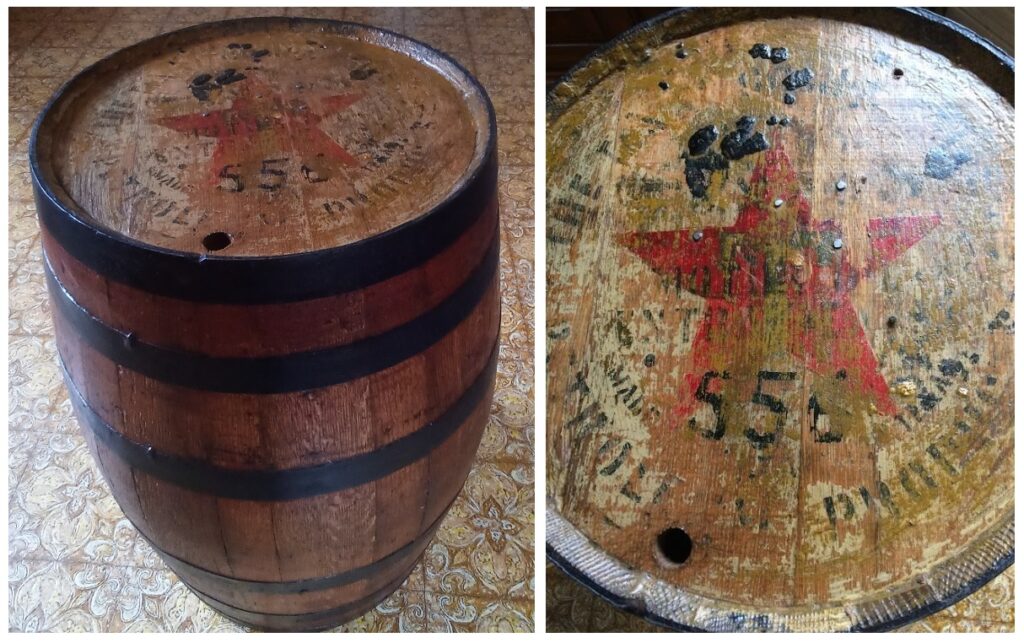
Please post reply in comments section below or email bawells@aoghs.org.
Reply
November 25, 2023
To Robert,
Your wood barrel is clearly “The Texas Company” (i.e., Texaco) container for “Petroleum Products.” Except for the red star with big green T, the rest of the lithography on your barrel is harder to interpret. My source for reference is Elton N. Gish’s self-published 2003 book Texaco’s Port Arthur Works. Unfortunately, the book does not have an index, but it has a lot of company photographs in it surrounded by narratives. Most of the photos of product containers are for metal cans and drums, but one group photo of a product display dated 1932 shows wood barrels still in use although metal drums predominate by that time. The only wood barrels discussed by Gish are for “slack barrels” used for asphalt, and it looks like you have some asphalt residue on your barrel top. Gish indicates that the “Red star-green T” trademark lithography began to be used by 1909 and continued to be used to present in various renditions, but a 1920s date range for you barrel seems reasonable. I hope this helps.
— Andy
Research Request: September 3, 2022
Identifying a Circa 1915 Gas Pump
From the lead mechanic at San Diego Air & Space Museum
I’m hoping someone visiting the American Oil & Gas Historical Society’s website can help me identify the gas pump we are restoring here at the San Diego Air and Space Museum. I believe it’s a Gilbert and Barker from 1915 or so.
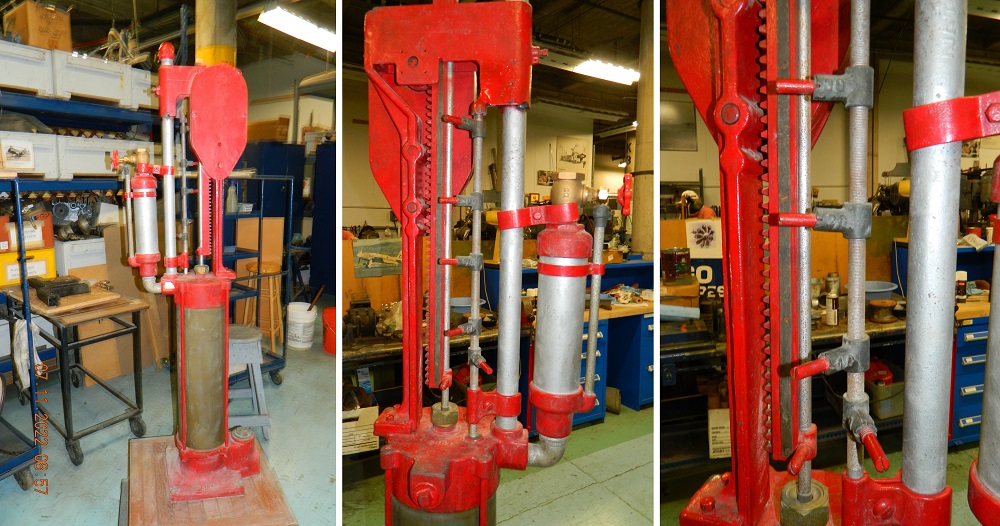
The data plate is missing and I’ve been having trouble finding a similar one in my online search. Thanks!
— Gary Schulte, Lead Mechanic, SDASM
Please email Gary engshop@sdasm.org or post your reply in the comments section below.
Learn more history about early kerosene and gasoline pumps in First Gas Pump and Service Station; a collector’s rare 1892 pump in Wayne’s Self-Measuring Pump; and the 24-hour Gas-O-Mat in Coin-Operated Gas Pumps.

Research Request: August 11, 2022
Gas Streetlights in the Deep South
From a professor, author and “history detective”
I am doing historical research on gas streetlights in the Deep South. Any suggestions will be much appreciated. My big problem at the moment is Henry Pardin. He bought the patent rights to a washing machine in Washington, DC, in 1856 and was in Augusta, Georgia, in 1856. Pardin set up gas streetlights in Baton Rouge, Holly Springs, Natchez, and Shreveport in 1857-1860. I have failed to find him in any of the standard research sources.
Any help on gas street lights in the south before the Civil War is appreciated. Thank you for your time.
— Prof. Robert S. “Bob” Davis, Blountsville, Alabama, Genws@hiwaay.net
Please email Bob or post your reply in the comments section below.
Research Request: August 5, 2022
Drop in Stop Action Film
From a stop action film researcher:
“Your website is doing good things for education. It is a gold mine for STEM high school teachers — and also for people like me, who like stop motion oil industry films, Bill Rodebaugh noted in an August 2022 email to the American Oil & Gas Historical Society.

Researcher seeks the origin of stop action film (oil?) drops.
Rodebaugh, who has researched many stop motion archives (including AOGHS links at Petroleum History Videos), seeks help finding the source of an unusual character — a possible oil drop with a face and arms. The purpose of the figures remains unknown.
“I am discouraged about finding that stop motion film, because I have seen or skimmed through many of those industry films, which are primarily live action,” Rodebaugh explained. He knows the puppet character is not from the Shell Oil educational films, “Birth of an Oil Field” (1949) or “Prospecting for Petroleum” (1956). He hopes a website visitor can assist in identifying the origin of the hand-manipulated drops. “I am convinced that if this stop motion film can be found, it would be very interesting.”
— Bill Rodebaugh, brodebaugh@suddenlink.net
Please email Bill or post your reply in the comments section below.
Research Request: July 2022
Gas Station Marketplace History
From an automotive technology writer:
I’m looking for any information on the financial environment during the early days of the automotive and gasoline station industry. The idea is to compare and contrast the market-driven forces back then to the potential for government subsidies/investments etc. to pay for electric vehicle charging stations today.
At this point, I have not found any evidence but I wanted to be thorough and ask the petroleum history community. From what I have seen, gas stations were funded privately by petroleum companies and their investors and shareholders.
I’m not talking about gas station design or the impact on the nation/communities, but the market forces behind the growth of the industry. Please let me know of any recommended sources. I have already read The Gas Station in America by Jackie & Sculle.
— Gary Wollenhaupt, gary@garywrites.com
Please email Gary or post your reply in the comments section below.
Research Request: April 2022
Seeking Information about Doodlebugs
From a Colorado author, consulting geologist and engineer:
I am trying to gather information on doodlebugs, by which I mean pseudo-geophysical oil-finding devices. These could be anything from modified dowsing rods or pendulums to the mysterious black boxes. Although literally hundreds of these were used to search for oil in the 20th century, they seem to have almost all disappeared, presumably thrown out with the trash. If anyone has access to one of these devices, I would like to know.
— Dan Plazak
Please post reply in comments section below or email bawells@aoghs.org. Dan Plazak is a longtime AOGHS supporting member and a contributor to the historical society’s article Luling Oil Museum and Crudoleum.

Research Request: February 2022
Know anything about W.L. Nelson of University of Tulsa?
From an associate professor of history at the Massachusetts Institute of Technology, Cambridge, Massachusetts:
I am doing research on the role of the University of Tulsa in the education of petroleum refining engineers and in particular am seeking information about a professor who taught there named W.L. Nelson, author of the textbook Petroleum Refinery Engineering, first published in 1936. He taught at Tulsa until at least the early 1960s. He was also one of the founders of the Oil and Gas Journal and author of the magazine’s “Q&A on Technology” column. If anyone has any leads for original archival sources by or about Nelson and UT, I would appreciate hearing from you.
Thank you and best wishes, M.G.
Please post reply in comments section below or email bawells@aoghs.org.
Emailed response to “Seeking Information about W.L. Nelson of University of Tulsa.”
My late father was a 1943 graduate of the University of Tulsa with a degree in petroleum engineering with an emphasis in refining. By the time my late uncle graduated in 1948, his degree had become chemical engineering with an emphasis in refining. Both had high regard for Wilbur L. Nelson. Both had long careers in the refining at Murphy Oil Corporation and Sun Oil Company. My father would pass along to me his obsolete Petroleum Refinery Engineering, as Nelson periodically updated his book. I will check my father’s papers for any Nelson relics. Let me know how your inquiry goes.
— Professional Engineer, El Dorado, Arkansas
————————
Oil History Forum
Research requests from 2021:
Star Oil Company Sign
Looking for information about an old porcelain sign from the Star Oil Company of Chicago.
Learn more in Seeking Star Oil Company.
Bowser Gas Pump Research
I have a BOWSER, pump #T25988; cut #103. This is a vintage hand crank unit. I can’t seem to find any info on it! Any help would be appreciated, Thank You. (Post comments below) — Larry

Hand-cranked Bowser Cut 103 Pump.
Originally designed to safely dispense kerosene as well as “burning fluid, and the light combustible products of petroleum,” early S.F. Bowser pumps added a hose attachment for dispensing gasoline directly into automobile fuel tanks by 1905. See First Gas Pump and Service Station for more about these pumps and details about Bowser’s innovations.
Bowser company once proclaimed its “Cut 103” as “the fastest indoor gasoline gallon pump ever made” with an optional “hose and portable muzzle for filling automobiles.”
Collectors’ sites like Oldgas.com offer research tips for those who share an interest in gas station technological innovations.
Circa 1900 California Oilfield Photo
My grandfather worked the oilfields in California in the early 1900’s.

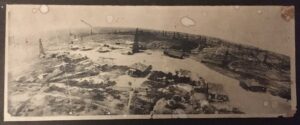
He worked quite a bit in Coalinga and also Huntington Beach. He had this in his old pictures. I would like to identify it if possible. The only clue that I see is the word Westlake at the bottom of the picture. What little research I could do led me to believe it might be the Los Angeles area?
I would appreciate any help you can provide. (Post comments below.) — B.
Cities Service Bowling Teams and Oil History
I was wondering if there are any records or pictures of bowling leagues and teams for Cities Service in the late 1950s and early 1960s in Houston, Texas, or Lafayette, Louisiana. I would appreciate any information. My dad was on the team. (Post comments below.) — Lisa
Oilfield Storage Tanks
My family has a farm in western PA and once had a small oil pump on the land. I’m trying to learn how the oil was transported from the pump. I know a man came in a truck more than once each week to turn on the pump and collect oil, but I don’t know if there was a holding tank, how he filled his truck, etc. (My mother was a child there in the ’40s and simply can’t recall how it all worked.) Can anyone point me at a resource that would explain such things? I’m working on a children’s book and need to get it right. Thank you. — (Post comments below.) Lauren
Author seeking Historical Oil Prices
Can anyone at AOGHS tell me what the ballpark figures are in the amount of petroleum products so far extracted, versus how much oil-gas is left in the world? Also: the price per barrel of oil every decade from the 1920s to the present. And the resulting price per gallon during the decades from 1920 to the present year? I have almost completed my book about an independent oilman. Please post reply in comments section below or email bawells@aoghs.org.
— John
Painting related to Standard Oil History
I am researching an old oil painting on canvas that appears to be a gift to Esso Standard Corp. Subject: Iris flowers. There is some damage due to age but it is quite interesting. The painting appears to be signed in upper right corner: Hirase?
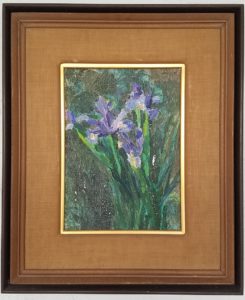
On the back, along each side, is Japanese writing that I think translates to “Congratulations Esso Standard” and “the Tucker Corporation” or “the Naniwa Tanker Corporation.” Date unknown, possibly 1920s.
I am not an expert in art nor Japanese culture, so some of my translation could be incorrect. I was hoping you or your colleagues might shed some light on this painting.
— Nancy
Please post oil history forum replies in the comments section below or email bawells@aoghs.org.
Early Gasoline Pumps
For the smaller, early stations from around 1930, was the gas stored in a tank in the ground below the dispenser/pump? — Chris Please ad comment below.
Oilfield Jet Engines
I was wondering about a neat aspect of oil and natural gas production; namely, the use of old, retired aircraft jet engines to produce power at remote oil company locations, and to pump gas/liquid over long distances in pipelines. Does anyone happen to recall what year a jet engine was first employed by the industry for this purpose? Nowadays, there is an interesting company called S&S Turbine Services Ltd. (based at Fort St. John, British Columbia) that handles all aspects of maintenance, overhaul and rebuilding for these industrial jets.
— Lindsey
Please post reply in comments section below or email bawells@aoghs.org.

Natalie O. Warren Propane Tanker Memorabilia
My father spent his working life with Lone Star Gas, he is gone many years now I am getting on. Going through a few of his things. A little book made up that he received when he and my mother attended the commissioning of the Natalie O. Warren Propane Tanker. I am wondering if it is of any value to anyone. Or any museum.
— Bill
Please post reply in comments section below or email bawells@aoghs.org.
Elephant Advertising of Skelly Oil
My grandfather owned a Skelly service station in Sidney, Iowa in the 1930s and 1940s. I have a photo of him with an elephant in front of the station. I recall reading somewhere that Skelly had this elephant touring from station to station as an advertising stunt. Does anyone have any more history on the live elephant tour for Skelly Oil? I’d love to find out more. — Jeff Please ad comment below.
Tree Stumps as Oilfield Tools
I am a graduate student at the Architectural Association in London working on a project that looks at the potential use of tree stumps as structural foundations. While researching I found the following extract from an article on The Petroleum Industry of the Gulf Coast Salt Dome Area in the early 20th century: “In the dense tangle of the cypress swamp, the crew have to carry their equipment and cut a trail as they go. Often they use a tree stump as solid support on which they set up their instruments.” I have been struggling to find any photos or drawings of how this system would have worked (i.e. how the instruments were supported by the stump) I was wondering if you might know where I could find any more information?
— Andrew
Post oil history forum replies in the comments section below or email bawells@aoghs.org.
Texas Road Oil Patch Trip
“Hi, next year we are planning a road trip in the United States that starts in Dallas, Texas, heading to Amarillo and then on to New Mexico and beyond. We will be following the U.S. 287 most of the way to Amarillo and would like to know of any oil fields we could visit or simply photograph on the way. From Amarillo we plan to take the U.S. 87. We realise this is quite a trivial request but you help would be much appreciated.”
— Kristin
Please post oil history forum replies in the comments section below or email bawells@aoghs.org.
Antique Calculator: The Slide Rule
Here’s a question about those analog calculating devices that became obsolete when electronic pocket calculators arrived in the early 1970s…Learn more in Refinery Supply Company Slide Rule.
Please post oil history forum replies in the comments section below or email bawells@aoghs.org.
—————
The American Oil & Gas Historical Society (AOGHS) preserves U.S. petroleum history. Please become an AOGHS annual supporter and help maintain this energy education website and expand historical research. Contact the society at bawells@aoghs.org if you would like a research question added. © 2025 Bruce A. Wells.
.
by Bruce Wells | Aug 19, 2025 | Petroleum History Almanac
Indiana researcher’s detailed “Informal History Notes” preserve U.S. petroleum company legacies.
James Hinds of Columbus, Indiana, originally completed his extensively researched history of the Indian Refining Company in November 2003. His work documented the early histories of Havoline Motor Oil (through 1962) and the Texas Company, the future Texaco (through 1985).
“Emphasis was placed on Indian Refining Company and on an accurate account of Havoline’s early days,” Hinds noted about his extensively researched “Informal History Notes” emailed to the American Oil & Gas Historical Society in 2023. He added, “Please feel free to use (or not use) as you see fit.”
James Hinds Informal History Notes
INDIAN REFINING COMPANY, INCORPORATED
HAVOLINE Motor Oil (through 1962)
The Texas Company / Texaco Inc. (through 1985)
Compiled by Jim Hinds, Columbus, Indiana
November 2003
In Memory of R. R. Hinds, Distributor
FOREWORD
1. These notes consist of information that I (with appreciable assistance) have been able to piece together on the corporate history of INDIAN REFINING COMPANY, INCORPORATED, the origins of HAVOLINE Motor Oil, and (to a lesser extent) the history of The Texas Company / Texaco Inc. Emphasis was placed on INDIAN REFINING COMPANY, and on an accurate account of HAVOLINE’s early days, since surprisingly little such information (especially on the “old INDIAN”) is readily available elsewhere. They are by no means a comprehensive history of The Texas Company / Texaco Inc. but only attempt to cover those events I believe were most relevant to the histories of INDIAN REFINING COMPANY and HAVOLINE Motor Oil.
2. I am aware that these notes conflict, in some details, with “The Texaco Story – The First Fifty Years 1902-1952” (Marquis James, The Texas Company, 1953), which has come to be viewed as the “official history” of The Texas Company. Based on information that I have verified through multiple independent sources, however, it appears that portions of the material with which Mr. James was given to work were either erroneous or misinterpreted.
3. It is recognized that “The Texas Company”, “TEXACO”, “HAVOLINE”, “INDIAN”, “FIRE-CHIEF”, and “Sky Chief” are or were registered trademarks of Texaco Inc. (a subsidiary of ChevronTexaco Corporation) or of its antecedents. They are used here for informational and historical research purposes only. These notes are in no way an official publication of Texaco Inc. or of ChevronTexaco Corporation.
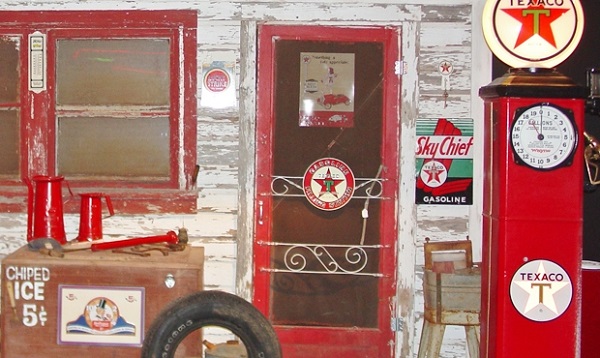
A Texaco station was among the 2012 indoor exhibits featured at the National Route 66 Museum in Elk City, Oklahoma. Photo by Bruce Wells.
Chronology
28 March 1901 – The Texas Fuel Company is among some 200 companies organized in the days immediately following the famed oil strike at Spindletop Hill near Beaumont, Texas. The company establishes an office in Beaumont.
4 October 1901 – John F. Havemeyer of Yonkers, New York incorporates The Havemeyer Oil Company under the laws of that state, for purposes (as detailed on its certificate of incorporation) related to “lubricating and all other oils of every kind and nature” (probably referring to whale oil, other animal renderings, and – possibly – to various seed oils, in addition to petroleum).
2 January 1902 – The Texas Fuel Company begins business.
7 April 1902 – The Texas Fuel Company becomes The Texas Company and incorporates under the laws of the State of Texas.
1 January 1903 – “TEXACO” (having originated as the cable address of The Texas Company) is first used as a product name.
13 November 1903 – The Texas Company begins operations at its first refinery – Port Arthur [Texas] Works
14 November 1904 – Although its plant is physically located in the tiny northwestern-Indiana hamlet of Asphaltum, and 99.8% of its common and 100% of its preferred stock are listed in the name of 23-year-old Richmond M. Levering (a Lafayette, Indiana native currently residing in Chicago, Illinois), Indian Asphalt Company incorporates under the laws of the State of Maine. (While not recorded, it is speculated that the name “Indian” is an allusion to Indiana – meaning land or place “of Indians”.)
1904 – The Havemeyer Oil Company — having developed a unique cold-filtration process and blending package for oils — coins, and first uses, the name “HAVOLINE.”
1905 – Realizing that the Jasper County, Indiana oil field which it originally intended to exploit is effectively depleted, Indian Asphalt Company is persuaded (in “an extensive campaign by the [Georgetown] Board of Trade”) to move its offices and plant to Georgetown, Kentucky.

1 May 1906 – Growing quickly in both size and scope, Indian Asphalt Company changes its name to INDIAN REFINING COMPANY. Its plant is upgraded to “refinery” status and its product line expanded to include paraffin wax, paint, “Sunset Engine Oil”, “Bull Dog Compound”, and “Blue Grass Axle Grease” in addition to asphalt. Richmond M. Levering becomes the first president of the renamed company and is soon joined in business by his father and mentor – Indiana banker, financier, and entrepreneur J. Mortimer Levering — who becomes the company’s secretary.
8 December 1906 – “HAVOLINE” is registered as a trademark of The Havemeyer Oil Company for use as a brand name on oils (not strictly motor oil) and greases.
5 January 1907 – Havoline Oil Company (a “spin-off” of The Havemeyer Oil Company) is incorporporated under the laws of State of New York. As with The Havemeyer Oil Company, its stated purposes include production, purchase, refining, sales, and other dealings involving “animal” oils and fats as well as “mineral” (i.e. petroleum) oils.
1907 – Construction of INDIAN REFINING COMPANY’s Lawrenceville, Illinois refinery is completed and the refinery begins operation.
1908 – Although continuing to operate its Georgetown refinery, INDIAN REFINING COMPANY relocates its offices to Cincinnati, Ohio. The company also begins operation of a small refinery near East St. Louis, Illinois.
20 May 1909 – As part of a program of rapid expansion, INDIAN REFINING COMPANY incorporates under the laws of the State of New York and purchases The Havemeyer Oil Company, Havoline Oil Company, and the by-now established “HAVOLINE” name (which is then registered as a trademark of INDIAN REFINING COMPANY as a brand name for lubricating oils – again, not strictly motor oil).
1909 – Production of HAVOLINE products at the Lawrenceville refinery begins.
1 December 1909 – Following a brief illness, J. Mortimer Levering (secretary of INDIAN REFINING COMPANY) passes away.
17 December 1909 – The Havemeyer Oil Company is dissolved.
2 September 1910 – INDIAN REFINING COMPANY (Maine) is chartered to do business in the State of Louisiana and begins operating a refinery in New Orleans.
1909-1911 – Also included in this period of INDIAN REFINING COMPANY’s expansion are the purchases of the Bridgeport Oil Company (Bridgeport, Connecticut), the Record Oil Refining Company (Newark, New Jersey), a small refinery in Jersey City, New Jersey, and control of a large storage station at Kearny, New Jersey. The company launches a program aimed at making a full-scale entry into the European market.

16 March 1911 – Primarily in anticipation of expanding to the West Coast, INDIAN REFINING COMPANY OF CALIFORNIA is created (and is incorporated under the laws of the State of New Jersey).
20 March 1911 – INDIAN REFINING COMPANY (New York) changes its name to INDIAN REFINING COMPANY OF NEW YORK and becomes the principal operating subsidiary of INDIAN REFINING COMPANY (Maine). The parent company’s main offices are moved from Cincinnati to New York City. Although its offices are moved, the company retains its close ties to the Cincinnati business community (which have existed since its inception as the Indian Asphalt Company) for many years. Its stock continues to be traded on the Cincinnati Stock Exchange and its board of directors includes (at various times) such well-known Cincinnati businessmen as William C. Procter, M. C. Fleischman, Lazard Kahn, and Bernard Kroger.
17 September – 6 November 1911 HAVOLINE Motor Oil lubricates the 28-horsepower engine of the first airplane to fly across the United States. Piloted by Calbraith Perry (“Cal”) Rodgers, the Wright EX bi-plane publicizes the new soft drink “Vin Fiz”, after which the the plane is named.
1 April 1912 – INDIAN REFINING COMPANY OF LOUISIANA incorporates under the laws of the
State of Louisiana.
December 1913 – January 1914 In conjunction with a sweeping organizational and financial restructuring, INDIAN REFINING COMPANY (Maine) applies for and receives “authority to do business” in the States of New York and California. It assumes those functions formerly performed by INDIAN REFINING COMPANY OF NEW YORK. The planned expansion to the far West, however, is effectively cancelled and INDIAN REFINING COMPANY OF CALIFORNIA is dissolved.
1915 – INDIAN REFINING COMPANY closes its Georgetown, East St. Louis, and Jersey City refineries and abandons the company’s European venture (which has proven to be a severe financial drain due largely the First World War).
1916 – INDIAN REFINING COMPANY (Maine)’s president, Richmond M. Levering, resigns, as do several other senior officers of the company.
December 1918 – January 1919 In yet another reorganization, INDIAN REFINING COMPANY OF NEW YORK, INDIAN REFINING COMPANY OF LOUISIANA, Havoline Oil Company, the Record Oil Refining Company, and the Bridgeport Oil Company – all subsidiaries of INDIAN REFINING COMPANY (Maine) (hereafter referred to simply as INDIAN REFINING COMPANY) – are dissolved. The New Orleans plant is closed.
1920 – INDIAN REFINING COMPANY purchases the capital stock of the Central Refining Company, which is located immediately north of the Lawrenceville refinery. The Central refinery facilities are ultimately reconfigured for lubricants manufacture.
1923 – The general offices of INDIAN REFINING COMPANY are moved from New York City to Lawrenceville.
1924 – INDIAN REFINING COMPANY sells its remaining producing properties (consisting mainly of wells and leases in Illinois and Ohio) to the Ohio Oil Company (later to become the Marathon Oil Company).
1924 – The globes for INDIAN gasoline pumps are redesigned: a red “ball” with “INDIAN” arched above and “GAS” arched below (both in blue letters) on a white globe, replaces the reddish-brown and black “running Indian” design which was previously used. (One-piece globes also include “HAVOLINE”, in letters, vertically on each side.)
1924-1925 – Wishing to even more closely associate the two names, INDIAN REFINING COMPANY adopts a totally re-designed “HAVOLINE” trademark and virtually identical “INDIAN GAS” logo, both of which prominently feature the red-white-and-blue “ball” which had first been incorporated into the “HAVOLINE” logo in 1922. A “dot” is added to the middle of the “D” and above the second “I” in the word “INDIAN” (replicating the dots within the “O” and above the “I” in “HAVOLINE”). “INDIAN HI-TEST” Gasoline (made identifiable by red dye) is introduced on a limited basis.
1926 – The subsidiary Indian Pipe Line Corporation is sold to the Illinois Pipe Line Company.
May 1926 – The Texas Company introduces “New and Better TEXACO Gasoline”.
26 August 1926 – The Texas Corporation is incorporated under the laws of the State of Delaware and, by exchange of shares, acquires substantially all outstanding stock of The Texas Company (Texas).
20 April 1927 – The Texas Company incorporates (under the laws of the State of Delaware) as the principal operating subsidiary of The Texas Corporation. All assets of The Texas Company (Texas) are transferred to The Texas Company (Delaware) and The Texas Company (Texas) is dissolved. The Texas Corporation becomes the “parent company” of the by-now numerous “Texas Company” entities and other subsidiaries.
2 March 1928 – The Texas Corporation acquires the California Petroleum Corporation, which is reorganized as The Texas Company (California).
16 August 1929 – Its chemists and engineers (led by Dr. Francis X. Govers) having perfected a revolutionary solvent-dewaxing process, INDIAN REFINING COMPANY introduces “HAVOLINE WAXFREE” motor oil, replacing “HAVOLINE –the power oil” (which had, early in the 1920’s, supplanted “HAVOLINE It Makes a Difference”). (An economy “Blended HAVOLINE” is also offered, primarily in bulk.)
By 1930 ,“HAVOLINE” sales (both nation-wide and overseas) not only remain strong but grow, markedly, following the introduction of “HAVOLINE WAXFREE”. But, while it had once been in the retail gasoline, kerosene, and fuel oil markets (to varying extents) in over 25 states, the growing effects of the Depression, increasing difficulty in competing with the larger oil companies, the lack of reliable sources of crude, and (especially) the huge amount of money spent in developing the Govers solvent-dewaxing process, combine to force INDIAN REFINING COMPANY to retrench and restrict such marketing to Indiana, Michigan, eastern Illinois, northern Kentucky, and western Ohio. (Within this limited area, however, the company still has a well-developed and efficient distribution and sales network. Into the latter 1920’s, for example, “INDIAN” accounts for some 20% of all gasoline sales in Indiana.)
1930 – The Texas Corporation introduces “TEXACO Ethyl Gasoline” (which is renamed “FIRE-CHIEF Ethyl” 15 April 1932).
August 1930: INDIAN REFINING COMPANY introduces a higher-octane “regular” gasoline which is made identifiable by green dye and which is dubbed “INDIAN Green-Lite” Gasoline.
14 January 1931 – The Texas Corporation gains controlling interest in INDIAN REFINING COMPANY, including the rights to HAVOLINE Motor Oil (and the all-important Govers solvent-dewaxing process) and INDIAN REFINING COMPANY’s
remaining active and inactive subsidiaries (the Indian Realty Corporation, the Central Refining Company, and the Havoline Oil Company of Canada, Ltd.). This also gives The Texas Corporation an established distribution and sales network
and entry into the retail gasoline market in Indiana, Michigan, eastern Illinois, northern Kentucky, and western Ohio – areas in which it has not previously had any significant presence. (The Texas Corporation limits use of the “HAVOLINE” name to motor oil, only; it is not again used on products other than motor oil until the mid-1990’s)
14 January 1931 – 15 March 1943 INDIAN REFINING COMPANY continues in operation as an “affiliate” of The Texas Corporation, although all sales outlets and company facilities and equipment are rebranded as “TEXACO.” Production of “TEXACO” gasolines begins at the Lawrenceville refinery. An “INDIAN” brand gasoline becomes a “sub-regular” (priced below “TEXACO” gasolines) and is added to the product line at most outlets, nationwide. Production of “INDIAN” gasoline is included at other Texas Corporation refineries. (It is during this period that “INDIAN” pumps bear a distinctive plate – either round or rectangular – featuring an art deco Indian beadwork design.) National marketing and sales offices for INDIAN REFINING COMPANY are opened in Indianapolis, Indiana.
15 April 1932 – “TEXACO FIRE-CHIEF Gasoline” is introduced.

1934 – Furfural solvent-extraction (developed by The Texas Corporation) is combined with the Govers solvent-dewaxing process in the manufacture of “HAVOLINE WAXFREE”.
1935 – Production of “HAVOLINE WAXFREE” at Port Arthur Works is begun in order to supplement the output of the Lawrenceville refinery.
May 1936 – “New TEXACO Motor Oil” (also produced with the solvent-dewaxing/furfural solvent-extraction process but with a totally different and less-expensive formulation than that of HAVOLINE) is introduced.
1938 – “HAVOLINE – DISTILLED AND INSULATED” is introduced.
October 1938 – “TEXACO Sky Chief Gasoline” is introduced (replacing “FIRE-CHIEF Ethyl”).
1 November 1941 – The Texas Company (California) is instructed to transfer all assets to The Texas Company (Delaware) and is then dissolved. The Texas Corporation “merges itself into” The Texas Company (Delaware). The Texas Company (Delaware) — hereafter referred to simply as “The Texas Company” — becomes the “parent company”.
15 March 1943 – INDIAN REFINING COMPANY’s stockholders transfer all of the company’s property and assets to The Texas Company in exchange for shares of that company’s stock. The Texas Company discontinues “INDIAN” gasoline and all other use in trade of the INDIAN name.
24 April 1943 – An agreement is implemented under which The Texas Company (partially by what amounts to cash purchase but, primarily, through exchange of shares) secures all INDIAN REFINING COMPANY stock, which is then cancelled. (INDIAN REFINING COMPANY, INCORPORATED is thus liquidated and is placed in “inactive corporation” status by the State of Maine (under whose laws it was incorporated) 31 December 1943.)
30 April 1943 – The Texas Company creates a second “Indian Refining Company”, which it incorporates under the laws of the State of Delaware – a “shell” company which it lists as an inactive subsidiary.
1946 – “New and Improved HAVOLINE” is introduced.
1950 – “Custom-Made HAVOLINE” is introduced.
Early 1950’s Lubricants production at the Lawrenceville refinery is discontinued; the lubricants production facility is dismantled and portions of that area of the property are disposed of.
1953 – “Advanced Custom-Made HAVOLINE” is introduced.
1955 – “Advanced Custom-Made HAVOLINE Special 10W-30” is introduced.
26 August 1958 – INDIAN REFINING COMPANY, INCORPORATED is officially dissolved by the State of Maine.
1 May 1959 – The Texas Company becomes Texaco Inc.
1962 – New HAVOLINE cans are introduced. The “TEXACO” trademark replaces the INDIAN REFINING COMPANY-era red-white-and-blue “ball” in a totally redesigned “HAVOLINE” logo.
1980 – For numerous reasons (among them the expense of needed technological upgrades), the prospects for the Lawrenceville refinery’s future profitability have eroded significantly. Unable to establish what might be a viable alternative means of supplying product to the area, Texaco Inc. makes the decision to withdraw from the retail gasoline market in that portion of the upper Midwest traditionally serviced by Lawrenceville.
1982 – The marking of all 55-gallon TEXACO drums becomes black with a red band. TEXACO oil drums had, historically, been gray with a green band with two exceptions. Drums of multi-grade (SAE 10W-30 and 10W-40) HAVOLINE Motor Oil were painted dark blue with a gold band and “head”. Those of “straight-grade” HAVOLINE were painted dark blue with a white band and head – Texaco Inc.’s last remaining use of The Havemeyer Oil Company’s original colors.
March 1985 – The diminution of reasonably-accessible sources of suitable crude, the cost of compliance with governmental regulations and other business considerations combine to make continued operation of the Lawrenceville refinery economically unfeasible. Texaco Refining and Marketing Inc. (a recently-formed subsidiary of Texaco Inc.) completes the withdrawal from the retail and wholesale motor fuels market in a contiguous area spanning Illinois, Indiana, Kentucky, and
Wisconsin. The Lawrenceville refinery is closed.
_______________________
Recommended Reading: The Texaco Story: The First Fifty Years, 1902-1952 (2012). Your Amazon purchase benefits the American Oil & Gas Historical Society. As an Amazon Associate, AOGHS earns a commission from qualifying purchases.
(2012). Your Amazon purchase benefits the American Oil & Gas Historical Society. As an Amazon Associate, AOGHS earns a commission from qualifying purchases.
_______________________
The American Oil & Gas Historical Society preserves U.S. petroleum history. Please become an AOGHS annual supporter and help maintain this energy education website and expand historical research. For more information, contact bawells@aoghs.org. Copyright © 2025 Bruce A. Wells. All rights reserved.
Citation Information – Article Title: “Histories of Indian Refining, Havoline, and Texaco.” Author: James Hinds. Website Name: American Oil & Gas Historical Society. URL: https://aoghs.org/oil-almanac/histories-of-indian-refining-havoline-and-texaco Last Updated: August 23, 2025. Original Published Date: June 21, 2023.
by Bruce Wells | Jul 8, 2025 | Petroleum Pioneers
Petroleum production began in 1902 near coastal oil seeps, but the real boom arrived in 1957.
Alaska’s petroleum history began long before statehood in 1959 and the major oilfield discovery two years earlier.
The first Alaskan oil well with commercial production was completed in 1902 in rugged, coastal territory where oil seeps had been known for years. (more…)
by Bruce Wells | Feb 13, 2025 | Petroleum in War
Shelling of the Ellwood field at Santa Barbara created mass hysteria — and the “Battle of Los Angeles.”
Soon after America entered World War II, an Imperial Japanese Navy submarine attacked a refinery and oilfield near Los Angeles, the first attack of the war on the continental United States. The submarine’s deck gun fired about two dozen rounds, causing little damage — but it resulted in the largest mass sighting of UFOs in American history.
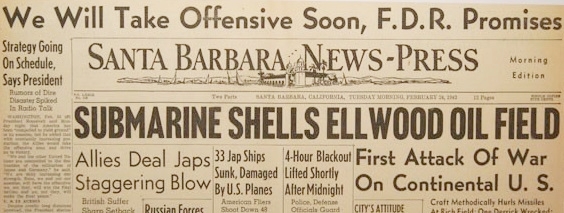
A February 1942 Imperial Japanese Navy submarine’s shelling of a California refinery caused little damage but created invasion (and UFO) hysteria in Los Angeles. Photo courtesy Goleta Valley Historical Society.
At sunset on February 23, 1942, Imperial Japanese Navy Commander Kozo Nishino and his I-17 submarine lurked 1,000 yards off the California coast. It was less than three months since the attack on Pearl Harbor, and Los Angeles residents were tense. (more…)






























